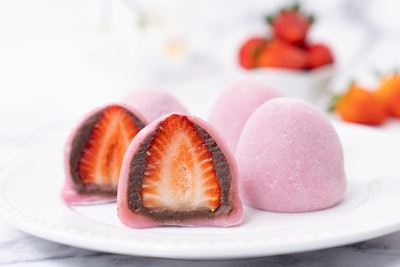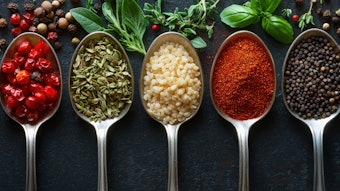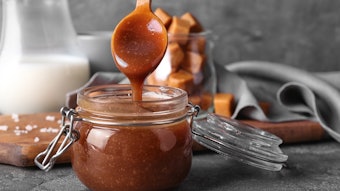
Today’s consumers are snacking more often: replacing breakfast or lunch, grabbing a healthy bite between meals, getting quick energy on the go and indulging in late-night snacks. In fact, 73% of United States consumers say they snack at least once a daya. This trend of all-day grazing, or “snackification,” is increasing demand for better-for-you snacks that offer nutritional benefits from ingredients like fiber, protein and biotics in support of digestion, energy, satiety and more. Ongoing interest in overall well-being, weight management and the rising popularity of the use of glucagon-like peptide-1 (GLP-1) agonist solutions means people are snacking in a mindful way.
 Mike Medinacourtesy of ADM
Mike Medinacourtesy of ADM
At the same time, enjoyment is elemental to the snackification trend. Flavor continues to come first, especially in foods with better-for-you ingredients or smaller serving sizes. Each bite is expected to have a pleasurable sensory impact with dimensional taste profiles and intriguing textures for a more gratifying snacking experience.
ahttps://store.mintel.com/us/report/us-snacking-motivations-and-attitudes-market-report/
Back to Basics
Many shoppers believe their favorite snacks are a necessary indulgence. They take comfort in familiar, mainstream flavors and recognizable ingredients, like toasted almond and dark chocolate cereal bars, roasted sweet potato chips and caramelized onion crackers. Recognizable sweeteners from natural sources, including honey, dates and agave, offer delightful flavor and sweetness while also supporting clean label targets. Additionally, cheese notes are transcending the traditional cheddar with broader use of distinct varietals, such as parmesan, blue and brie, in snack applications ranging from dips to fillings to seasonings.
Kitchen pantry ingredients and wholesome inclusions contribute different textures, visual appeal and bolder flavors. Crunchy, seasoned chickpeas are having a moment as high-protein snacks, while nuts, seeds and multigrains are a fiber-rich staple in bars, crackers, clusters, trail mixes, granola bites and more. Lots of these familiar ingredients can also support more satiating food choices. A recent Mintel report finds that weight-conscious consumers seek to add products to their routine that target satiety effectsb, which is now being further influenced by on-trend GLP-1 agonists. Fiber from ancient grains, beans and pulses, along with prebiotic dietary fiber from other natural sources like corn starch, are gaining prominence, particularly as fiber is the number one ingredient consumers seek for reasons like satiety and weight management, in addition to digestive supportc.
bhttps://www.mintel.com/press-centre/mintel-announces-global-consumer-trends-for-2023/
cADM Outside Voice℠
The trend of all-day grazing, or “snackification,” is increasing demand for better-for-you snacks that offer nutritional benefits from ingredients like fiber, protein and biotics in support of digestion, energy, satiety and more.
 Consumers are looking to save while splurging by searching for bulk-style variety packs, bite-size versions of the original or pre-portioned servingsAdobe Stock
Consumers are looking to save while splurging by searching for bulk-style variety packs, bite-size versions of the original or pre-portioned servingsAdobe Stock
Premium Snacks without the Price
Snacking is a way for consumers to infuse joy into their day, and people are willing to indulge more in treats with exquisite taste. However, affordability concerns have many people monitoring their spending habits, even as they look for elevated sensory experiences and tailored functional offerings. Notably, of the 77% of global consumers who have recently reduced restaurant spending, 46% say they are buying more premium treats at home as a form of compensationd.
Shoppers are also willing to pay for the perception of quality, and that’s where the #dupe trend is making waves within the food and snacking sectors. Whether it’s premium flavors in private label offerings or a more accessible version of a luxury brand, consumers are interested in upscale affordability. For example, rather than scooping up fresh caviar with a gourmet cracker, consumers may be satisfied with the umami element of roe-flavored puffs. Sophisticated flavor descriptors can also signal premiumization, such as espresso vs. coffee, limoncello vs. lemon, and truffle vs. chocolate. Other ways for consumers to save while splurging include bulk-style variety packs, bite-size versions of the original or pre-portioned servings, such as on-the-go pudding cups with an enhanced flavor and mouthfeel that more closely emulates luxurious French pots de crème.
Premiumization is also conveyed with specialty and limited-time offerings that provide an air of exclusivity. Beyond seasonal and holiday flavors (pink lemonade frosted cookies), think “mood food” concepts (mocha crisp energy bars) or co-branded promotions (snack mix with chile-lime tajin seasoning). Incorporating global flavors like tiramisu and churro, and botanical flavors like lavender and elderflower, also adds a premium perception to snacks. Consumers can enjoy the novelty of the snacks along with the perk of being in the know.
dhttps://fmcggurus.com/reports/fmcg-gurus-top-ten-trends-for-2024-global-report/
 Some notable innovations include chimichurri-flavored popcorn, mango yogurt with black sea salt, dried pineapple glazed with chamoy, and chocolate-covered strawberry mochi gummies (pictured).Adobe Stock
Some notable innovations include chimichurri-flavored popcorn, mango yogurt with black sea salt, dried pineapple glazed with chamoy, and chocolate-covered strawberry mochi gummies (pictured).Adobe Stock
E-commerce & Exploration
Nearly half (48%) of US consumers say they enjoy trying new-to-them snacks and flavors of snacks. Plus, about 4 in 5 consumers are actively seeking new and unusual flavors that challenge their sensory perceptionse. This desire may be partially influenced by what consumers are viewing on their screens – and what they can try at the tap of a button. As more direct-to-consumer sites pop up online, shoppers have greater access to flavors and formats that are typically harder to find on store shelves. The same is true of social media and its capacity to broaden awareness of regionally focused flavors.
Global influences can add complexity to one-note flavors, often with overlapping elements of spicy, sweet, salty, smoky and so on. Some notable innovations include chimichurri-flavored popcorn, mango yogurt with black sea salt, dried pineapple glazed with chamoy, and chocolate-covered strawberry mochi gummies. There’s also continued interest in spice and new sources of hot(ter) flavors, like smoky Scotch bonnet chile queso chips. Innovative and nuanced flavor profiles up the enjoyment of the snacking experience.
Plus, smaller portion sizes enable consumers to sample fun new flavors without committing to a complete meal. Mail-order snack boxes are gaining popularity while introducing subscribers to taste sensations from around the globe. For example, a box of treats from Thailand might deliver tempura-fried seaweed, sour spaghetti-style gummy candy, dried coconut flakes flavored like roasted sweetcorn, and sandwich cookies filled with custard cream. With a global pantry from which to choose and convenient delivery options, these subscription boxes are sure to keep the snackification trend going.
ehttps://fmcggurus.com/reports/fmcg-gurus-flavor-color-texture-in-emea-in-north-america-regional-report-2023/
Satisfactory Snacking
As snacking has become further ingrained in daily behaviors, consumers have higher expectations for foods that not only meet baseline needs for taste, price and convenience but also support their lifestyle goals. This has opened the market to a broader range of snacks, from the familiar enjoyment of traditional chips and cookies to the nutritional benefits of health-forward puffs, bars and bites. The line between meals and snacks continues to blur, and flavorists have the exciting opportunity to create delicious treats that fuel both body and mind. Whether working on a new concept or transforming an existing favorite, finding a partner with the right portfolio, technical expertise and ingenuity will help brands develop snacks that satisfy consumers who want it all.










